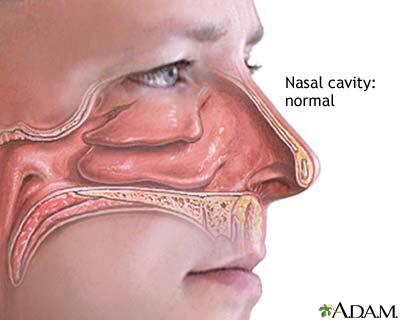| Allergic rhinitis |
Hay fever (allergic rhinitis) involves an allergic reaction to pollen. A virtually identical reaction occurs with allergy to mold, animal dander, dust, and similar inhaled allergens. The pollens that cause hay fever vary from person to person and from region to region. Pollens that are carried by bees from plant to plant are seldom responsible for hay fever because the grains are large and have a waxy coating. Tiny, hard-to-see pollens carried by the wind are more often the cause of hay fever.

Normal Allergic rhinitis
Examples of plants commonly responsible for hay fever include:
- Trees (deciduous and evergreen)
- Grasses
- Weeds (such as ragweed)
In addition to individual sensitivity and geographic differences in local plant populations, the amount of pollen in the air can be a factor in whether hay fever symptoms develop. Hot, dry, windy days are more likely to have increased amounts of pollen in the air than cool, damp, rainy days where pollen is washed to the ground.
When an allergen such as pollen or dust is inhaled by a person with a sensitized immune system, it triggers antibody production; these antibodies bind to cells that contain histamine. Histamine (and other chemicals) are released by these cells when the antibodies are stimulated by allergens. This causes itching, swelling of affected tissues, mucus production, muscle spasms, hives, rashes, and other symptoms. Symptoms vary in severity from person to person.
Symptoms
- Coughing
- Headache
- Itching of the nose, mouth, eyes, and throat
- Runny nose (rhinorrhea)
- Smell -- impaired
- Sneezing
- Sore throat
- Stuffy nose (nasal congestion)
- Watery eyes
- Wheezing
The patient's history is important in diagnosing hay fever, including whether the symptoms vary according to time of day, the season, exposure to pets, diet changes, or other sources of potential allergens.
Skin testing is the most common method of allergy testing. This may include scratch, prick, or intradermal tests. Occasionally, the suspected allergen is dissolved and dropped onto the lower eyelid (conjunctiva) of the eye as a means of testing for allergies.
There are specific blood tests that can be used to diagnose hay fever, but they are less helpful than skin tests.
Treatment
The best "treatment" is to avoid what causes your allergies in the first place. It may be impossible to completely avoid everything you are allergic to, but you can often take steps to reduce your exposure.
Medication options include the following:
- Short-acting antihistamines, which are generally non-prescription, often relieve mild-to-moderate symptoms but older ones can cause drowsiness and blunt learning in children (even in the absence of drowsiness). An example is diphenhydramine (Benadryl).
- Longer-acting antihistamines cause less drowsiness and can be equally effective, and usually do not interfere with learning. These medications include fexofenadine (Allegra), cetirizine (Zyrtec), levocetirizine (Xyzal), desloratadine (Clarinex), and loratadine (Claritin).
- For people with symptoms not relieved by antihistamines alone, nasal corticosteroid sprays are very effective and safe. These prescription medications include fluticasone (Flonase), mometasone (Nasonex), and triamcinolone (Nasacort AQ).
- Decongestants may also be helpful in reducing symptoms such as nasal congestion, but should not be used for long periods.
- Cromolyn sodium is available as a nasal spray (Nasalcrom) for treating hay fever. Eye drop versions of cromolyn sodium and antihistamines are available for itchy, bloodshot eyes.
Allergy shots (immunotherapy) are occasionally recommended if the allergen cannot be avoided and symptoms are hard to control with medication. It includes injections once or twice a week of the allergen, given in increasing doses (each dose is slightly larger than the previous one) that may help the body adjust to the antigen. Allergy shots demand a significant time commitment. It can take 6 - 8 months to reach the most effective (monthly) "maintenance dose," depending on how well the buildup to that does is tolerated in the patient over time.
Symptoms may sometimes be prevented by avoiding known allergens. Most trees produce pollen in the spring, grasses usually produce pollen during the summer, and ragweed and other late-blooming plants produce pollen during late summer and early autumn. During the pollen-producing times (pollen season), people with hay fever may prefer to remain indoors in an air conditioned-atmosphere whenever possible. For people that are sensitive to certain indoor allergens, dust mite covers for mattresses and pillowcases are recommended, as well as avoidance of culprit pets or other triggers.
Reference
Golden DB, Moffitt J, Nicklas RA, et al. Stinging insect hypersensitivity: A practice parameter update 2011. J Allergy Clinical Immunology. April 2011;127(4):852-854.e23.
Reviewed By: Paula J. Busse, MD, Assistant Professor of Medicine, Division of Clinical Immunology, Mount Sinai School of Medicine, New York, NY, Review provided by VeriMed Healthcare Network. Also reviewed by David Zieve, MD, MHA, Medical Director, A.D.A.M., Inc.
